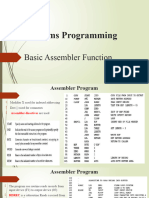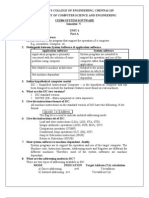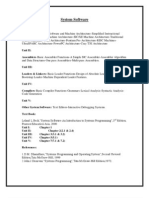6 RISCvsCISC
6 RISCvsCISC
Uploaded by
AnushiMaheshwariCopyright:
Available Formats
6 RISCvsCISC
6 RISCvsCISC
Uploaded by
AnushiMaheshwariOriginal Description:
Original Title
Copyright
Available Formats
Share this document
Did you find this document useful?
Is this content inappropriate?
Copyright:
Available Formats
6 RISCvsCISC
6 RISCvsCISC
Uploaded by
AnushiMaheshwariCopyright:
Available Formats
RISC vs CISC
System Bus
System Bus
A bunch of parallel wires
Transfer data among the components
Address bus (determine the amount of physical memory
addressable)
Data bus (indicate the size of the data transferred)
Control bus (consists of control signals:
memory/IO read/write, interrupt, bus
request/grand)
Every different processor has its own design
(different registers, buses, micro-operations, machine instructions, etc)
Program
A sequence of (machine) instructions
(Machine) Instruction
A group of bits that tell the computer to perform a specific operation (a sequence of micro-operation)
The Input Register (INPR) holds an 8 bit character gotten from an
input device
The Output Register (OUTR) holds an 8 bit character to be send to
an output device
CPU
CISC vs. RISC
SIX Instruction Set Design Issues
Number of Addresses
Flow of Control
Operand Types
Addressing Modes
Instruction Types
Instruction Formats
Processor
RISC and CISC designs
Reduced Instruction Set Computer (RISC)
Simple instructions, small instruction set
Operands are assumed to be in processor registers
Not in memory
Simplify design (e.g., fixed instruction size)
Examples: ARM (Advanced RISC Machines),
DEC Alpha (now Compaq)
Complex Instruction Set Computer (CISC)
Complex instructions, large instruction set
Operands can be in registers or memory
Instruction size varies
Typically use a microprogram
Example: Intel 80x86 family
CISC Methodology: Use additional hardware to perform
code translation and optimization.
Complex instructions written in a high
level language translate directly into
exactly one instruction in assembler.
Complex Instructions:
To multiply two numbers,
first load each operand from
a location in main memory
(locations 1:1 through 6:4)
into one of the six registers
(A, B, C, D, E, or F). Once
loaded, they can be
multiplied by the execution
unit (or ALU).
1. LOAD [A, 2:3]
2. LOAD [B, 5:2]
3. MULT [A, B]
4. STORE [2:3, A]
Complex Instructions:
CISC rolls up this
instruction set into one
compact instruction to
be handled by the
decoder.
MULT [2:3, 5:2]
Microcode engine
within the CPU
decodes the complex
instructions and
executes microcode
programs to carry out
the task
Pros and Cons of CISC:
Pro:
Complex instructions operate
directly on main memory.
Programmer is no longer
required to do a direct call to
LOAD and STORE operations
as they are now handled by
hardware.
Compiler has less work to
translate statements in a high
level language to assembly
language.
Con:
Microcode became more
difficult to test and debug as
systems became more
complex requiring numerous
patches to fix bugs.
Processor (cont.)
Processor (cont.)
Variations of the ISA-level can be implemented
by changing the microprogram
Instruction Set Design Issues
Number of Addresses
Flow of Control
Operand Types
Addressing Modes
Instruction Types
Instruction Formats
Number of Addresses
Four categories
3-address machines
2 for the source operands and one for the result
2-address machines
One address doubles as source and result
1-address machine
Accumulator machines
Accumulator is used for one source and result
0-address machines
Stack machines
Operands are taken from the stack
Result goes onto the stack
Number of Addresses (cont.)
Three-address machines
Two for the source operands, one for the
result
RISC processors use three addresses
Sample instructions
add dest,src1,src2
; M(dest)=[src1]+[src2]
sub dest,src1,src2
; M(dest)=[src1]-[src2]
mult dest,src1,src2
; M(dest)=[src1]*[src2]
Number of Addresses (cont.)
Example
C statement
A = B + C * D E + F + A
Equivalent code:
mult T,C,D ;T = C*D
add T,T,B ;T = B+C*D
sub T,T,E ;T = B+C*D-E
add T,T,F ;T = B+C*D-E+F
add A,T,A ;A = B+C*D-E+F+A
Number of Addresses (cont.)
Two-address machines
One address doubles (for source operand & result)
Last example makes a case for it
Address T is used twice
Sample instructions
load dest,src ; M(dest)=[src]
add dest,src ; M(dest)=[dest]+[src]
sub dest,src ; M(dest)=[dest]-[src]
mult dest,src ; M(dest)=[dest]*[src]
Number of Addresses (cont.)
Example
C statement
A = B + C * D E + F + A
Equivalent code:
load T,C ;T = C
mult T,D ;T = C*D
add T,B ;T = B+C*D
sub T,E ;T = B+C*D-E
add T,F ;T = B+C*D-E+F
add A,T ;A = B+C*D-E+F+A
Number of Addresses (cont.)
One-address machines
Use special set of registers called accumulators
Specify one source operand & receive the result
Called accumulator machines
Sample instructions
load addr ; accum = [addr]
store addr ; M[addr] = accum
add addr ; accum = accum + [addr]
sub addr ; accum = accum - [addr]
mult addr ; accum = accum * [addr]
Number of Addresses (cont.)
Zero-address machines
Stack supplies operands and receives the result
Special instructions to load and store use an address
Sample instructions
push addr ; push([addr])
pop addr ; pop([addr])
Load/Store Architecture
Instructions expect operands in internal processor registers
Special LOAD and STORE instructions move data between
registers and memory
RISC uses this architecture
Reduces instruction length
Load/Store Architecture (cont.)
Sample instructions
load Rd,addr ;Rd = [addr]
store addr,Rs ;(addr) = Rs
add Rd,Rs1,Rs2 ;Rd = Rs1 + Rs2
sub Rd,Rs1,Rs2 ;Rd = Rs1 - Rs2
mult Rd,Rs1,Rs2 ;Rd = Rs1 * Rs2
Flow of Control
Default is sequential flow
Several instructions alter this default
execution
Branches
Unconditional
Conditional
Delayed branches
Flow of Control (cont.)
e.g., Pentium e.g., SPARC
Operand Types
Instructions support basic data types
Characters
Integers
Floating-point
Instruction overload
Same instruction for different data types
Example: Pentium
mov AL,address ;loads an 8-bit value
mov AX,address ;loads a 16-bit value
mov EAX,address ;loads a 32-bit value
Addressing Modes
How the operands are specified
Operands can be in three places
Registers
Register addressing mode
Part of instruction
Constant
Immediate addressing mode
All processors support these two addressing modes
Memory
Difference between RISC and CISC
CISC supports a large variety of addressing modes
RISC follows load/store architecture
Instruction Types
Several types of instructions
Data movement
mov dest,src
add Rdest,Rsrc,0 ;Rdest = Rsrc+0
Arithmetic and Logical
Arithmetic
Integer and floating-point, signed and unsigned
add, subtract, multiply, divide
Logical
and, or, not, xor
Instruction Types (cont.)
Flow control and I/O instructions
Branch
Interrupts
I/O instructions
Memory-mapped I/O
Most processors support memory-mapped I/O
No separate instructions for I/O
in AX,io_port ;read from an I/O port
out io_port,AX ;write to an I/O port
Instruction Formats
Two types
Fixed-length
Used by RISC processors
32-bit RISC processors use 32-bits wide instructions
Examples: SPARC, MIPS, PowerPC
Variable-length
Used by CISC processors
Memory operands need more bits to specify
You might also like
- Wireshark Lab: Ethernet and ARP v7.0: 1 ObjectiveDocument9 pagesWireshark Lab: Ethernet and ARP v7.0: 1 ObjectiveHugo Gustavo100% (1)
- ZTE ZXSDR B8200 Product Description PDFDocument30 pagesZTE ZXSDR B8200 Product Description PDFK Ouertani67% (3)
- COA Unit 3Document52 pagesCOA Unit 3guptakrishns23No ratings yet
- CAO Unit 1 Part 2-1Document5 pagesCAO Unit 1 Part 2-1prut.joshNo ratings yet
- Lecture 14 - Instruction FormatsDocument5 pagesLecture 14 - Instruction FormatsPragya SinghNo ratings yet
- COA Unit2 - G MaityDocument23 pagesCOA Unit2 - G MaityhalumsonaNo ratings yet
- Module3 ISADocument51 pagesModule3 ISAwatsontamilNo ratings yet
- Isa 1Document13 pagesIsa 1awais_alii56No ratings yet
- Chapter04 ProcessorDesign PDFDocument39 pagesChapter04 ProcessorDesign PDFTrần Thảo NguyênNo ratings yet
- Unit 3 - Computer Architecture - WWW - Rgpvnotes.inDocument14 pagesUnit 3 - Computer Architecture - WWW - Rgpvnotes.inNathuram GodseNo ratings yet
- System Software - Unit IDocument77 pagesSystem Software - Unit IJASPER WESSLYNo ratings yet
- Week 2Document22 pagesWeek 2Shubhadeep GhatakNo ratings yet
- CPU Organization Bindu AgarwallaDocument22 pagesCPU Organization Bindu AgarwallaNobodyNo ratings yet
- Ch2 - Lec2 - Instruction Sets CharacteristicsDocument48 pagesCh2 - Lec2 - Instruction Sets CharacteristicsMagarsaa Qana'iiNo ratings yet
- CompArch 02 CPUDocument105 pagesCompArch 02 CPUmilkii kasayeNo ratings yet
- Unit One NotesDocument92 pagesUnit One NotesbharathimmkNo ratings yet
- Ch2 Lec2 Instruction Sets CharacteristicsDocument46 pagesCh2 Lec2 Instruction Sets CharacteristicsAlazar DInberuNo ratings yet
- Motorola68k 2Document114 pagesMotorola68k 2SoumyabrataPatraNo ratings yet
- Coa Unit - 2 Important QuestionsDocument17 pagesCoa Unit - 2 Important QuestionskarthikanegofficialNo ratings yet
- Comparch 03 CPUDocument85 pagesComparch 03 CPUsewasewtadeleNo ratings yet
- 5 PDFDocument30 pages5 PDFsuhaeb fazelNo ratings yet
- University Solved Answers Unit 1 SS (System Software Notes)Document12 pagesUniversity Solved Answers Unit 1 SS (System Software Notes)Vaishnavi Rave100% (1)
- Instructions and Instruction SequencingDocument25 pagesInstructions and Instruction Sequencingsamueljamespeter100% (4)
- System Software and Compiler DesignDocument34 pagesSystem Software and Compiler Designsourabha DNo ratings yet
- Instruction Set ArchitectureDocument27 pagesInstruction Set Architecturejeroro6730No ratings yet
- 04 Assimpler1Document28 pages04 Assimpler1ahmedNo ratings yet
- William Stallings Computer Organization and Architecture 7 EditionDocument40 pagesWilliam Stallings Computer Organization and Architecture 7 EditionHanani RamliNo ratings yet
- AnnaDocument73 pagesAnnaDriti DasNo ratings yet
- Chapter 2: Advanced Computer ArchitectureDocument101 pagesChapter 2: Advanced Computer ArchitectureTigabu Yaya100% (2)
- Hw2 SolutionDocument8 pagesHw2 SolutionTun LeNo ratings yet
- General Register OrganizationDocument16 pagesGeneral Register OrganizationGovind UpadhyayNo ratings yet
- Instruction Set Architecture: Logic and Computer Design FundamentalsDocument50 pagesInstruction Set Architecture: Logic and Computer Design FundamentalslogintojalluriNo ratings yet
- l18 ArmDocument71 pagesl18 ArmVamsi SomisettyNo ratings yet
- Computer Architecture Unit 2 - Phase 1 PDFDocument52 pagesComputer Architecture Unit 2 - Phase 1 PDFvithyaNo ratings yet
- Coa Unit III Part IIDocument23 pagesCoa Unit III Part IIkontham sirisejaNo ratings yet
- Instruction SetDocument5 pagesInstruction SetSaad SaeedNo ratings yet
- System Software Question Bank 2012 With Part-B AnswersDocument49 pagesSystem Software Question Bank 2012 With Part-B Answerssumathi7975% (16)
- Chapter 4Document48 pagesChapter 4wogayehu.ANo ratings yet
- William Stallings Computer Organization and Architecture: Instruction Sets: Characteristics and FunctionsDocument30 pagesWilliam Stallings Computer Organization and Architecture: Instruction Sets: Characteristics and FunctionsreinaldoopusNo ratings yet
- Computer Organization and Assembly Language: Lecture 11 & 12 Instruction Sets: Characteristics and FunctionsDocument17 pagesComputer Organization and Assembly Language: Lecture 11 & 12 Instruction Sets: Characteristics and Functionsdarwinvargas2011No ratings yet
- Prof. S.G.GollagiDocument41 pagesProf. S.G.GollagiDivya SinghNo ratings yet
- ch1 FullDocument57 pagesch1 FullNhongTranNo ratings yet
- cs2304 System Software 2 Marks and 16 Marks With AnswerDocument18 pagescs2304 System Software 2 Marks and 16 Marks With Answermanojkumar024No ratings yet
- 2 MarksDocument17 pages2 MarksGeetha ParthibanNo ratings yet
- Chapter 02Document4 pagesChapter 02John doeNo ratings yet
- SsDocument60 pagesSsponns100% (1)
- System Software NotesDocument104 pagesSystem Software NotesVishal PatelNo ratings yet
- Instruction Format and Addressing ModesDocument15 pagesInstruction Format and Addressing Modesmadhurimapatra198788% (34)
- Sic and SIC/XEDocument14 pagesSic and SIC/XEravneet_mahal198100% (1)
- Instruction CodesDocument35 pagesInstruction Codesanilk_patiNo ratings yet
- Systems Programming AssignmentDocument24 pagesSystems Programming Assignmentvajahat07No ratings yet
- Chapter 3 Csa SummaryDocument10 pagesChapter 3 Csa Summarycsa94No ratings yet
- Lecture 7Document23 pagesLecture 7Syed MuneebNo ratings yet
- Ss 1Document78 pagesSs 1NithiBoazNo ratings yet
- Lecture 4 Program Loops and ArraysDocument50 pagesLecture 4 Program Loops and ArraysAnonymous E9ySJLqsNo ratings yet
- Cpu DesignDocument105 pagesCpu Designridersonthestorm1No ratings yet
- Practical Reverse Engineering: x86, x64, ARM, Windows Kernel, Reversing Tools, and ObfuscationFrom EverandPractical Reverse Engineering: x86, x64, ARM, Windows Kernel, Reversing Tools, and ObfuscationNo ratings yet
- 8086 Microprocessor Programming & Instruction Sets:: Immediate AddressingDocument8 pages8086 Microprocessor Programming & Instruction Sets:: Immediate AddressingbiniamNo ratings yet
- ApplicationsDocument44 pagesApplicationsmerinjose123100% (1)
- Unit 2 CaoDocument8 pagesUnit 2 CaoZamal AhmedNo ratings yet
- C Programming for the Pc the Mac and the Arduino Microcontroller SystemFrom EverandC Programming for the Pc the Mac and the Arduino Microcontroller SystemNo ratings yet
- Quickspecs: Technical SpecificationsDocument42 pagesQuickspecs: Technical SpecificationsDigital WorldNo ratings yet
- Sound Via 13014 DriversDocument385 pagesSound Via 13014 DriversJorge More CuadrosNo ratings yet
- Improvements For 802,11 NDSS05-abbrDocument24 pagesImprovements For 802,11 NDSS05-abbrcain velazquezNo ratings yet
- N2P Elastix Step by Step - EnglishDocument8 pagesN2P Elastix Step by Step - EnglishovirogerNo ratings yet
- Manual RouterOS6 NewsDocument1,132 pagesManual RouterOS6 NewsszejkdudiNo ratings yet
- 5th Class Islamiyat Notes PDFDocument41 pages5th Class Islamiyat Notes PDFMuhammad Ali100% (1)
- Vaddis® 5A Product BriefDocument2 pagesVaddis® 5A Product BriefBen Bouchard-MillerNo ratings yet
- Restoring Exchange Mailbox Data V1.0Document10 pagesRestoring Exchange Mailbox Data V1.0Tony FreekzNo ratings yet
- Panasonic TX-P42UX30E Plasma TelevisionDocument20 pagesPanasonic TX-P42UX30E Plasma TelevisionAntonioTechNo ratings yet
- iMet-1-RSB Radiosonde XDATA Daisy Chaining PDFDocument2 pagesiMet-1-RSB Radiosonde XDATA Daisy Chaining PDFReno ChoiNo ratings yet
- Use of Information Technology in E-CommerceDocument5 pagesUse of Information Technology in E-CommerceAtif SarwarNo ratings yet
- Anju YadavDocument3 pagesAnju YadavakhandddddNo ratings yet
- NBU 8 0 Technical PPT Enterprise Vault Jan 2017Document25 pagesNBU 8 0 Technical PPT Enterprise Vault Jan 2017AbdulrahMan MuhammedNo ratings yet
- 200905Document104 pages200905Som SuperNo ratings yet
- V24-Tty Passive ManualDocument1 pageV24-Tty Passive ManualJair PinhoNo ratings yet
- ZEBRA XiIII Xi3 Parts, Service ManualDocument219 pagesZEBRA XiIII Xi3 Parts, Service ManualadonayNo ratings yet
- Universal Protocol Converter User Manual: Intelligence in ValidationDocument24 pagesUniversal Protocol Converter User Manual: Intelligence in ValidationManuel Salvador Leiva GomezNo ratings yet
- VB6 0 IntroDocument15 pagesVB6 0 IntrosanpunethaNo ratings yet
- Program To Copy A String in Reverse Order in Assembly Language Using Visual Studio PDFDocument2 pagesProgram To Copy A String in Reverse Order in Assembly Language Using Visual Studio PDFDilawarNo ratings yet
- Crime File ManagementDocument42 pagesCrime File ManagementJayanth Jay86% (7)
- Mopub - StartAppDocument7 pagesMopub - StartAppdafaNo ratings yet
- VoIP Office Presentation-Ilovepdf-Compressed PDFDocument14 pagesVoIP Office Presentation-Ilovepdf-Compressed PDFAnoyNo ratings yet
- Hack A Computer On Your Network With Kali LinuxDocument7 pagesHack A Computer On Your Network With Kali LinuxAmrit RajNo ratings yet
- Report Format and Guidelines Six WeekDocument11 pagesReport Format and Guidelines Six WeekVishal SharmaNo ratings yet
- User Guide: MODEL GDI-WHA6001... GDI-WHA6010Document52 pagesUser Guide: MODEL GDI-WHA6001... GDI-WHA6010romeroNo ratings yet
- Write A Lex Program To Count No of Identifiers, Keywords, DigitsDocument13 pagesWrite A Lex Program To Count No of Identifiers, Keywords, DigitsBhargavi Chowdary100% (2)
- 10 1 1 104Document34 pages10 1 1 104Sunita SahNo ratings yet
- Course Syllabi (2017 - 2021) : Second Year Bachelor of Technology Computer EngineeringDocument4 pagesCourse Syllabi (2017 - 2021) : Second Year Bachelor of Technology Computer EngineeringAmit SonawaneNo ratings yet

























































































